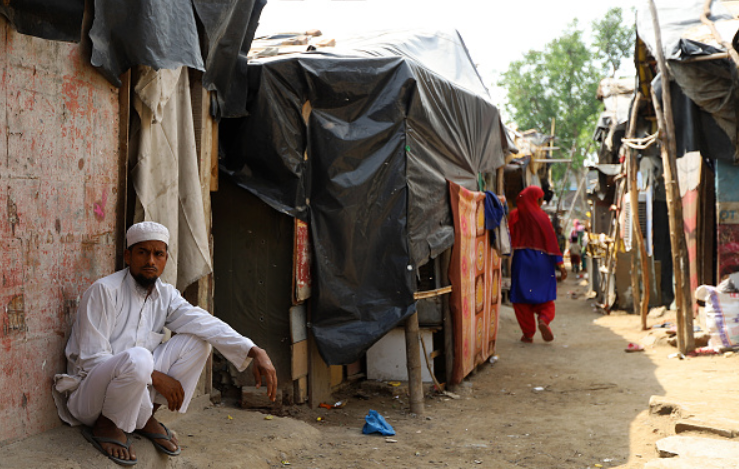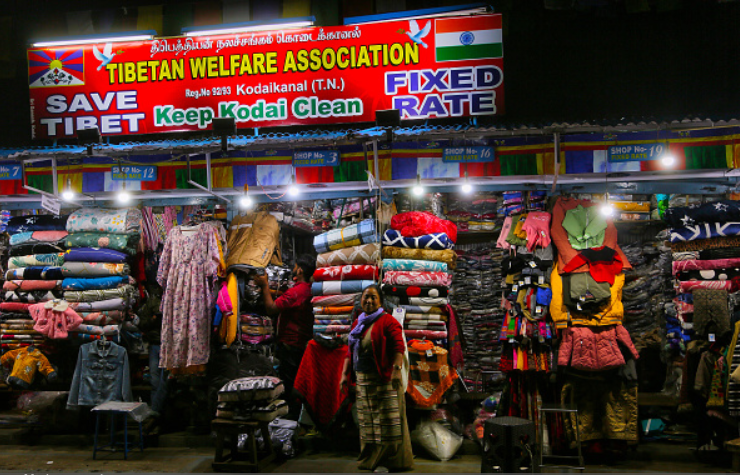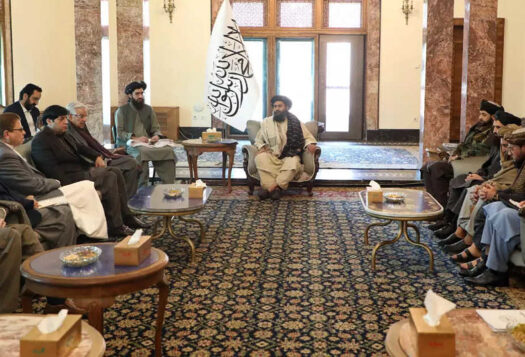
On August 17, Indian Minister for Housing and Urban Affairs, Hardeep Singh Puri, sparked a Twitter controversy on the presence of Rohingya refugees in the capital. Puri tweeted that Rohingya in New Delhi would be relocated from slum-like camps to flats in the Bakkarwala neighborhood of Delhi and provided with basic amenities, UNHCR cards, and Delhi police protection. However, this ‘landmark decision’ was swiftly reversed: within hours, the Ministry of Home Affairs tweeted that such a decision was never approved and Rohingya refugees would be sent to detention camps to be deported back to Myanmar, where they face severe ethnoreligious persecution. While seemingly mundane, the Twitter feud garnered national and international media attention as it was symptomatic not only of inefficient federal machinery, but also of the gaps in India’s refugee policy.
For a country with foundations in the forced displacement of the 1947 Partition, and one with more than 200,000 refugees, India has no international or domestic refugee policy. While India has historically been deemed a ‘safe haven’ for refugees, the absence of a formal law allows the state to deal with refugee groups on an ad hoc and arbitrary basis, governed not by international, humanitarian, or constitutional considerations but by geopolitical and diplomatic incentives, domestic electoral mandates, and local socio-cultural dynamics. The absence of a domestic refugee policy allows for a level of strategic ambiguity in India’s policy response. Given increasing levels of forced migration in the region due both to conflict and climate change, India must find the political will to create renewed refugee legislation for a uniform, unbiased, and predictable administrative policy towards refugees.
Strategic Ambiguity in India’s Refugee Law
India is not party to the 1951 Refugee Convention or its 1967 Protocol, which provide the definitions and obligations of host countries towards those facing persecution. Furthermore, India does not acknowledge the administrative role of the UNHCR within its territory and chooses to handle refugee crises unilaterally. Only about 46,000 of the 200,000 refugees in India have received formal protection from the UNHCR office in New Delhi, while others either receive state recognition or are entirely undocumented. Differentiated architectures of documentation from state and international actors, along with newer national identification technologies like Aadhar, have made it increasingly challenging for refugees to gain access to necessities, assert economic and political needs, and gain recognition from the state on a uniform basis.
While India has historically been deemed a ‘safe haven’ for refugees, the absence of a formal law allows the state to deal with refugee groups on an ad hoc and arbitrary basis…
The 1946 Foreigners Act is the main law that deals with the treatment of non-citizens in India. However, this law does not have a distinct ‘refugee’ category delineating specific rights, addressing refugees at the political and administrative, rather than legal and judicial levels, and handling them in the same manner as undocumented migrants, tourists, and foreigners. If and when the Center violates constitutional rights, judicial intervention is sparse and insufficient, necessitating clear-cut legal definitions. The legal conflation of refugees and ‘illegal migrants’ is even more dangerous in the face of increasing national political rhetoric against migration and rising anti-Muslim sentiment under the Modi regime.
Moreover, India’s treatment of its own marginalized groups has shaped its policy approaches towards supposed ‘outsiders.’ For example, the 1955 Citizenship Act was first revised in response to the Assam Movement in 1985, ensuring the naturalization of all migrants who entered before 1971, while mandating that those entering after 1971 be deported. With the 2019 amendment (the Citizenship Amendment Act or CAA), all non-Muslim refugees from Afghanistan, Pakistan, and Bangladesh are eligible for Indian citizenship, making religion a formal criterion for state protection. While there are some benefits to avoiding a one-size-fits-all policy approach, the state’s lack of a moral imperative coupled with widespread anti-Muslim sentiment inevitably engenders biases in the treatment of various refugee groups.
Ad Hoc and Arbitrary: Between Geopolitics and Humanitarianism
In the absence of formal legislation, the dynamics of political realism and prescriptive ethnonationalism have shaped India’s responses to successive influxes of refugees. For instance, while India did not militarily interfere with the Chinese occupation of Tibet in 1959, it wholeheartedly welcomed Tibetan refugees. Capitalizing on nationalistic fervor against Chinese aggression at the shared border in 1962 and widespread public support for the Tibetan cause, the government used Tibetan refugees as political pawns, both in vote-bank politics and in increasingly tense Sino-Indian relations. Nehru sought creative policy solutions, such as institutionalizing the Central Tibetan Administration in Dharamsala, allocating land for refugees, and setting up Tibetan schools. Again, in 1971, India housed ten million Bangladeshi refugees to secure its own security interests in its war against Pakistan by having a ‘friend’ on one side and a ‘rival’ on the other. Electoral politics and local-level communal dynamics also largely shaped regional rehabilitation and repatriation responses. While West Bengal welcomed and extended aid to refugees due to shared cultural and linguistic affinities, refugees in Assam were met with hostility due to growing fears of a resource shortage and differences in religion and language.

The Nehruvian approach to hospitality, rooted in harrowing experiences of the Partition, has deteriorated in recent years with the rise of the BJP and its changing diplomatic and domestic priorities. For instance, since 2017, India has criminalized and deported Rohingya refugees fleeing ethnoreligious violence in Myanmar. Approximately 40,000 Rohingya live in slum-like settlements across the country, with only about half protected by the UNHCR. The government response to the Rohingya has had overt communal undertones, with BJP officials calling refugees ‘termites’ and ‘terrorists.’ However, New Delhi’s dubious stance on Rohingya refugees can also be attributed to its desire to walk the diplomatic tightrope with Myanmar. The country is a vital diplomatic partner: it connects South and Southeast Asia, shares intelligence with India on border insurgencies, and provides the raw material for India’s technology industry. Myanmar’s importance in India’s regional security calculus has meant that New Delhi has not engaged in mediation on Rohingya repatriation between Bangladesh and Myanmar, as China has done.
Similarly, while India began an electronic visa (E-visa) program for Afghan refugees after the U.S. withdrawal last year, it is unclear how many approvals New Delhi has granted of the 60,000 asylum applications received since August 2021. India has suggested it would prioritize applications from Hindus and Sikhs attempting to flee the country. However, given Afghanistan’s majority-Muslim population, India’s hesitation to accept Afghan refugees seems rooted in its discriminatory CAA policy and the BJP’s staunch Islamophobia. However, from a geopolitical lens, New Delhi’s shifting stance toward the Taliban may also affect its negligence of Afghan refugees. While the Taliban hopes to gain economic and developmental assistance from India, New Delhi seeks to leverage the relationship to gain assurances against potential anti-India terrorism arising from Afghanistan, which puts humanitarian assistance for Afghan refugees on the backburner.
The Way Forward
In recent years, South Asia has experienced new drivers of migration, precipitating new refugee flows. Economic collapse in Sri Lanka, food insecurity in Afghanistan and Pakistan, and the imminent threat of rising sea levels on Bangladesh and the Maldives evoke an urgent need for India to reconsider its policy frameworks and humanitarian obligations toward non-citizens. Reliance on the archaic Foreigners Act of 1946 and the discriminatory Citizenship Amendment Act of 2019 puts India at odds with its global image. Therefore, an all-encompassing framework that abides both by Indian constitutional law and international customary law is vital.
Economic collapse in Sri Lanka, food insecurity in Afghanistan and Pakistan, and the imminent threat of rising sea levels on Bangladesh and the Maldives evoke an urgent need for India to reconsider its policy frameworks and humanitarian obligations toward non-citizens.
Additionally, India can learn from its past management of large refugee inflows. Under the international humanitarian framework, host states can respond to refugees through repatriation, integration, or resettlement in a third country, leaving little room for creative policymaking. In the Tibetan case, the relative isolation of Tibetan settlements in the hilly regions of Himachal Pradesh prevented market saturation and local hostilities. Indian collaboration with semi-sovereign institutions like the Central Tibetan Administration (CTA) provided a means for political self-organization, cultural preservation, and a sense of belonging to the homeland. While highly context-specific, the Tibetan case provides a model for cooperation between host countries, civil society organizations within countries of origin, and international organizations, to come up with creative solutions beyond the international triadic framework.
Given that the current BJP government seems to benefit from an ambiguous legal framework, India lacks the political will to formulate a sustainable refugee policy, preferring to act on geopolitical priorities and religious biases. However, to abide by international customary law and Indian constitutional law—as well as to avoid the security issues that come with the presence of undocumented migrants—India must consider formulating a uniform refugee law. With judicial oversight, cooperation with civil and international organizations, and attention to the international status quo, a standard refugee policy would provide legal pathways to asylum and prevent unjust administrative actions, such as the National Registry of Citizens, from implementation at the national level. In this way, it would not only benefit India’s non-citizens, but also India’s nominal citizens—Muslims, Dalits, and the poorest without papers, who navigate such spaces of legal ambiguity daily.
***
Click here to read this article in Urdu.
Image 1: Amarjeet Kumar Singh/Anadolu Agency via Getty Images
Image 2: Creative Touch Imaging Ltd./NurPhoto via Getty Images


